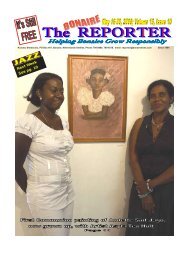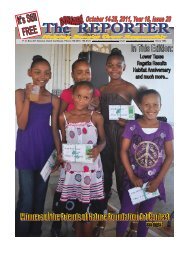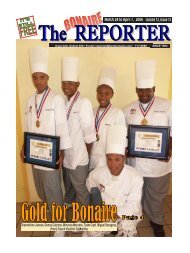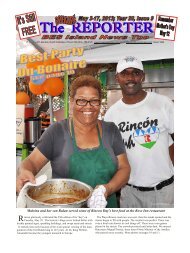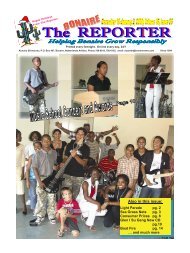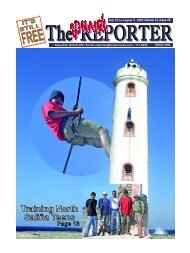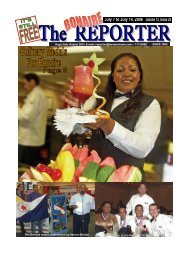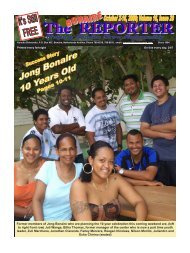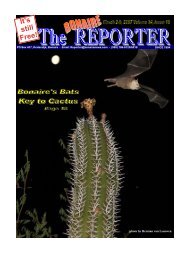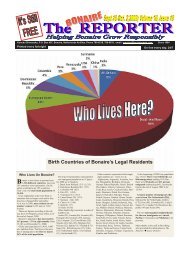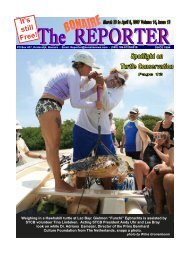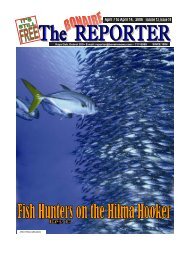Create successful ePaper yourself
Turn your PDF publications into a flip-book with our unique Google optimized e-Paper software.
s has become a tradition on Christmas, Sea Turtle<br />
A Conservation <strong>Bonaire</strong> (STCB) prepared an overview<br />
of this year’s satellite tracking activity and included<br />
our prior years’ work as well.<br />
STCB’s Andy Uhr writes: “Our plans for 2006 called<br />
for us to track two turtles. Unfortunately due to some technical<br />
issues with a transmitter, some poor luck and some<br />
mistakes on our part, we only tracked one, ‘Heit’. In late<br />
November we thought the last breeding female had left the<br />
area, but in mid-December we were surprised to discover<br />
two others had arrived. We did manage to capture one, a female hawksbill, on December<br />
15, right at sunset, directly in front of the Divi Flamingo Hotel, and were ready to<br />
deploy the second satellite transmitter. Upon closer examination of the turtle, it was<br />
apparent that she was very old, not in good condition and she was released immediately.<br />
At the same time, dive operators reported seeing the second hawksbill in the water<br />
near Harbor Village. Intensive efforts, including two nights on Klein <strong>Bonaire</strong> hoping<br />
she would come ashore to lay her eggs, and two days of searching in the water from<br />
Small Wall to Harbor Village, were unsuccessful.<br />
2005 and 2006 Satellite Tracking<br />
‘Heit’s track is the “pinkish” line in the lower right of the map that is shown above<br />
in the right-hand column. As you can see comparing her path to all the others, she<br />
headed in a different and, at least for us, an unexpected direction. In August, she arrived<br />
at her home foraging grounds in the Los Roques Archipelago approximately 180<br />
km from <strong>Bonaire</strong>. In October, Mabel Nava, STCB Project Director and Gielmon<br />
“Funchi” Egbreghts, STCB Project Assistant, traveled for a one-week working session<br />
with their counterparts in Los Roques and attempted to retrieve ‘Heit’s transmitter.<br />
While the search for ‘Heit’ was unsuccessful, the trip provided an excellent opportunity<br />
to compare field techniques used by both projects, to learn from one another, and<br />
to establish a cooperative relationship in order to improve the protection of our sea<br />
turtles. <strong>The</strong> trip, funded by the World Wildlife Foundation (WWF), is the beginning<br />
of an ongoing collaborative effort between STCB and La Fundacion Cientifica Los<br />
Roques (FCLR).<br />
<strong>Bonaire</strong> <strong>Reporter</strong> - December 29 to January 5, 2007<br />
2005 and 2006 Satellite Tracking<br />
As for 2007, current plans call for us to track two turtles. In November, Queen<br />
Beatrix of the Netherlands visited <strong>Bonaire</strong> and agreed to sponsor a satellite transmitter<br />
for 2007. <strong>The</strong> turtle will be named for her eldest grandchild, Eloise. <strong>The</strong> other turtle<br />
will be named Darwin<br />
at the request<br />
of Karen and Ken<br />
Miller, our very<br />
patient and understanding<br />
sponsors<br />
for 2006.<br />
Again we want to<br />
also thank ‘Heit’s<br />
sponsors, Jeannette<br />
and Ria Heitkönig.<br />
Our best wishes<br />
to all for a happy<br />
holiday season and<br />
the best of New<br />
Years.” Andy Uhr 2003 and 2004 Satellite Tracking<br />
Page 13



